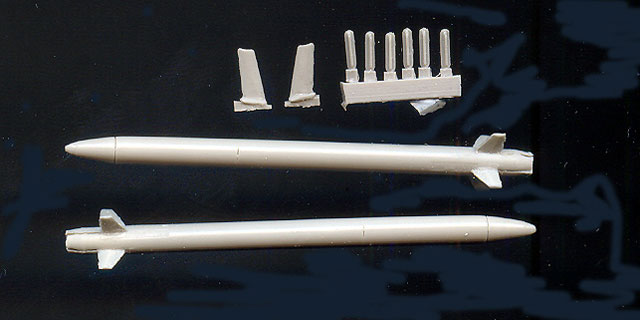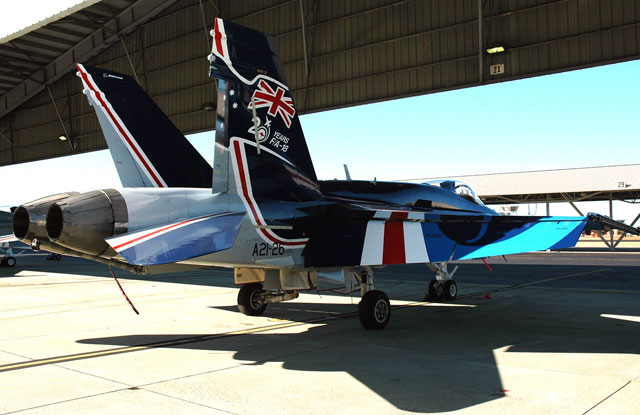|
Reviewed by Rodger Kelly

HyperScale is proudly supported by
Squadron.com
This
Canadian decal manufacturing company seem to have taken a shine to anniversary
markings applied to the F/A-18 Hornet if their catalogue is any indication. In
1/48 scale, alone they list a huge eight sheets. Sheet number eight though is a
departure from their normal coverage of Canadian Forces aircraft in that it is
for a Royal Australian Air Force machine.
The RAAF is
not normally known for flamboyant markings. Indeed their previous
landmark/anniversary schemes have been some what restrained and barely
memorable. Things seem to have changed though and when the 20th anniversary of
the F/A-18 in RAAF usage was reached the scheme applied to A21-26 is truly
remarkable!
To quote
from the Australian Government Department of Defence media release:
"In October 1981, Australia signed a contract for the
provision of 75 F/A-18 Hornet aircraft, of which 18 were two-seat aircraft
configuration. The first two aircraft were produced in the United States, with
the remainder being assembled by the Government Aircraft Factories (GAF) in
Victoria, Australia. The Royal Australian Air Force (RAAF) received its first
Hornet at RAAF Base Williamtown's No. 2 Operational Conversion Unit (2OCU) in
May 1985. 2OCU commenced Hornet Pilot Training shortly after in August 1985. As
such, this year the RAAF will celebrate 20 years of successful F/A-18 Hornet
Operations.
F/A-18 Hornet A21-26, a single seat RAAF Hornet aircraft has been painted in a
celebratory ' Year of the Hornet ' anniversary paint scheme. The commemorative
design was decided by holding a RAAF wide design competition. The winning
design was initiated by Sergeant David Turnbull, a current member of
77 Squadron located at RAAF Base Williamtown. Painting of the aircraft was
undertaken in the Aerospace Coatings facility at the Boeing Aerospace Support
Centre (BASC) - RAAF Base Amberley in February 2005. Now completed, the
aircraft will return to RAAF Base Williamtown on Tuesday 1 March 2005 before
being officially launched at the Avalon Air Show in Victoria on 15 March 2005 by
the Chief of Air Force, Air Marshal Angus Houston."
So there you
have the background. Now what do you get for your money? Well, quite a bit
really. The set comprises three full size sheets, a smaller sheet containing
the squadron badges of the five squadrons that operate the Hornet in RAAF
service, a pair of resin dummy Advanced Short Range Air to Air Missiles (ASRAAM),
a pair of RAAF unique VHF antennas, and six "bird slicer" antennas for the nose
(you only need five of these).
The supplied
markings are very complete indeed and include decals for the ASRAAMS as well as
markings that were seen on the pilot's flight helmet. Spare 'blocks' of the two
different blues are also included in case you need to patch any recalcitrant
hard-to- conform areas such as the fin reinforcement wedges.

Click the thumbnails below to view larger images:
Leading Edge
supply clear comprehensive support material to assist you in creating your scale
masterpiece. The first of these are in the form of two A-4 sized placement
guide/instruction sheets. Thankfully, appropriate scale (the sheet is available
in 1/72, 1/48 and 1/32 scale) templates to assist you in masking the complex
paint scheme. Also included on one of these sheets are colour close-up
photographs to illustrate some of the more difficult to illustrate areas of
application like the insides of the intakes. If you are going to tackle this
beast, my recommendation is that you study these sheets very carefully before
you start the project as they provide you with diagrams for placement of the
resin antenna as well as what colours to use for the inside of gear doors and
intakes. A helpful paint match to available model paints is also provided. The
other support material is in the form two colour sheets. The first sheet
contains side and plan views whilst he other sheet contains oblique colour
photographs of the airborne machine that show the top and bottom surfaces and a
further three quarter starboard rear shot.
Did they get
it right? Heck it looks pretty good to me and with input from RAAF personnel
(and modellers) like Ken Bowes, I'm sure that they have.

I was
fortunate enough to have a walk around of the one-to-one-scale A21-26 when it
was at the RAAF Pearce for their air show last November and, with the placement
guides in hand for comparison purposes did notice a couple of differences. The
decal sheet provides five squadron badges for either side of the nose. On the
day I saw it, the port side of the machine was only carrying one badge whilst
the starboard side carries four. Closer examination however revealed that these
vinyl stick-on squadron badges had been removed, probably through wear. The
rest of the markings however looked pretty true to the original.
I have only
used Leading Edge once before and they worked well. These ones look to be the
same so I would not expect any problems with them. One advantage with them is
that the white looks to be very dense so it should survive being applied over
dark blue with ease.
Any
disadvantages? Yes, the printing of the squadron badges is a little pixelated
but to be fair to Leading Edge, this would not be easy to better than what they
have provided.
The sheet is
listed on the Leading Edge site at USD$32.14 (USD$34.00 with the resin parts) in
1/32 scale, USD$19.00 in 1/48 scale (USD$24.00 with the resin parts) and
USD$11.00 in 1/72 scale (USD$14.00 with the resin parts). Not cheap by any
means but to be fair, there are three full sized sheets as well as resin parts
in the set.
Please note
that I have based this review on the 1/48 scale sheet. The appropriate
supporting material and number of decal sheets varies with the scale of the
sheet.
The decal
sheets, placement guides and resin parts come packed in separate clear plastic
zip-loc bags.
All up, this
is a well researched and well produced product from Leading edge.
Recommended
Footnote
I have
included some of the pics that I took that Saturday but they are not the
greatest as the machine was parked in one of RAAF Pearce's "carport" shelters
and was very difficult to photograph.

Click the thumbnails below to view larger images:
If you
are after some reference pics though head your browser to
http://www.defence.gov.au/fotoweb/Grid.fwx?archiveId=5000&search=(IPTC025%20contains%20(20th%20Anniversary)
The page
is from the official RAAF gallery and contains some really excellent modeller
friendly photographs. My tip would be to download these images fairly quickly as
they won't be there forever.
Thanks to Dave Koss at Leading Edge for the review sample
The full range of Leading Edge
Models products can be viewed at
www.lemdecal.com
The product range can be ordered
by contacting Leading Edge at
lemdecal@telusplanet.net or by snail mail (E, 83
Skyline Cres., N.E. Calgary, AB, T2K 5X2 Canada)
Review and Reference Photos Copyright © 2006 by Rodger Kelly
This Page Created on 29 June, 2006
Last updated 29 June, 2006
Back to HyperScale
Main Page
Back to Reviews
Page
|
Home | What's
New | Features
| Gallery |
Reviews | Reference
| Forum
| Search